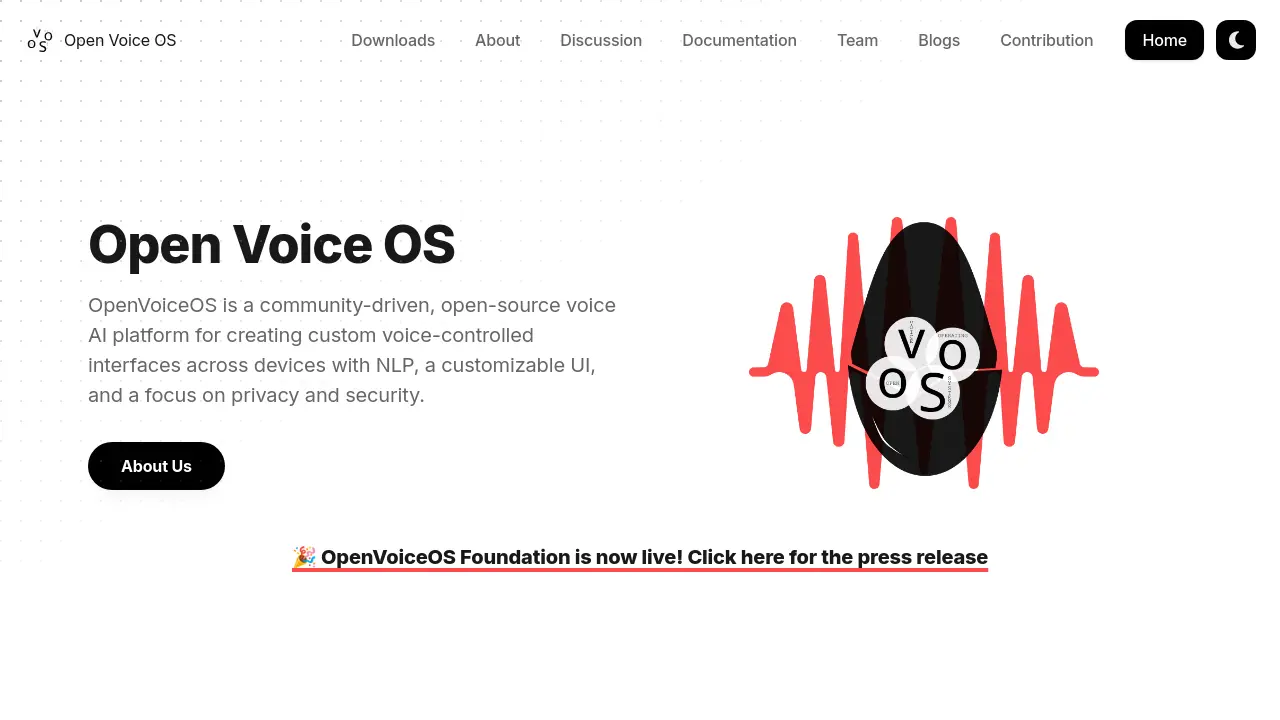Open Voice OS
Community-Driven Open-Source Voice AI Platform

Description
Open Voice OS (OVOS) is an open-source, community-powered platform designed for developing custom voice-controlled interfaces. It leverages Natural Language Processing (NLP) and offers a customizable user interface, catering to a variety of devices from embedded headless systems and single-board computers to DIY smart speakers. The platform emphasizes privacy and security in its design.
Developed collaboratively by a global community from Linux and FOSS backgrounds, OVOS serves as an experimental playground for cutting-edge voice assistance technology. It allows developers to test new features and supports contributions for specific devices or platforms. OVOS originated from the Mycroft community and maintains compatibility while introducing enhanced functionalities, positioning itself as an independent, community-focused alternative.
Key Features
- Community-Driven Development: Powered by developers from global Linux and FOSS communities.
- Open-Source Platform: Freely available source code for transparency and modification.
- Multi-platform Support: Runs on embedded headless devices, single-board computers (with screens), and supports DIY smart speaker builds.
- Natural Language Processing (NLP): Incorporates NLP for understanding voice commands.
- Customizable UI: Allows for tailoring the user interface.
- Privacy and Security Focus: Built with user privacy and data security in mind.
- Experimental Core: Acts as a testing ground for new voice AI features.
- Multiple Installation Options: Offers installation via Docker, Python virtual environments, or a simple installer script.
- Prebuilt Images: Provides ready-to-use images for Raspberry Pi and Mycroft® devices.
- Offline Capability Potential: Some skills and self-hosted STT options can work offline.
Use Cases
- Creating custom voice-controlled interfaces for various devices.
- Building DIY smart speakers.
- Developing voice assistants for embedded systems and low-spec hardware.
- Experimenting with and contributing to open-source voice AI technology.
- Integrating privacy-focused voice control into products (for businesses).
Frequently Asked Questions
How did Open Voice OS started?
Open Voice OS started as MycroftOS. Over time, more Mycroft community members joined the project, and it was renamed to OpenVoiceOS to avoid trademark issues. Initially, Open Voice OS focused on bundling Mycroft-core and creating companion software, but due to contributions not being accepted upstream, we now maintain an enhanced reference fork of Mycroft-core with extra functionality while keeping all companion software Mycroft-core (dev branch) compatible. You can think of Open Voice OS as the unsanctioned "Mycroft Community Edition".
What is the relationship between Open Voice OS and Mycroft?
Both projects are fully independent. Initially, Open Voice OS focused on wrapping Mycroft-core with a minimal OS, but as both projects matured, Open Voice OS-core was created to include extra functionality and make Open Voice OS development faster and more efficient. Open Voice OS has been committed to keeping our components compatible with Mycroft, and many of our changes are submitted to Mycroft to include in their projects at their discretion.
Does Open Voice OS work offline?
By default, ovos-core does not require a backend internet server to operate. Some skills can be accessed (via command line) entirely offline. The default speech-to-text (STT) engine currently requires an internet connection, though some self-hosted, offline options are available. Individual skills and plugins may require internet.
You Might Also Like
TinyWow.cc
FreeUnlimited Creation, 100% Free.
MARK•R
FreemiumMARK•R: From Highlight To Insight
KeyMouse
Pay OnceEfficient Keyboard and Mouse Combined for Maximum Productivity
FindYourTriggers
Free TrialUnderstand yourself and take control of your life
Headcanon Generator
FreeAI Tool for Generating Unique Character Ideas